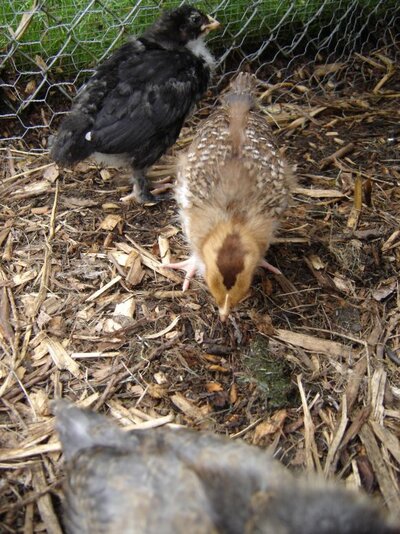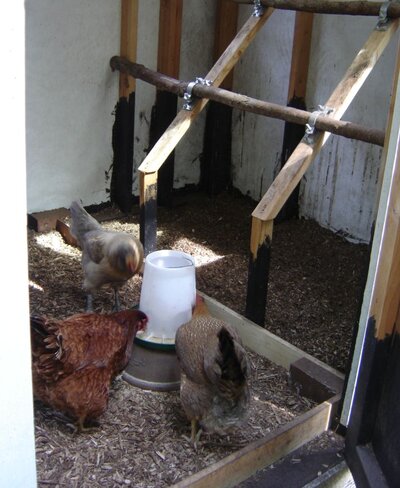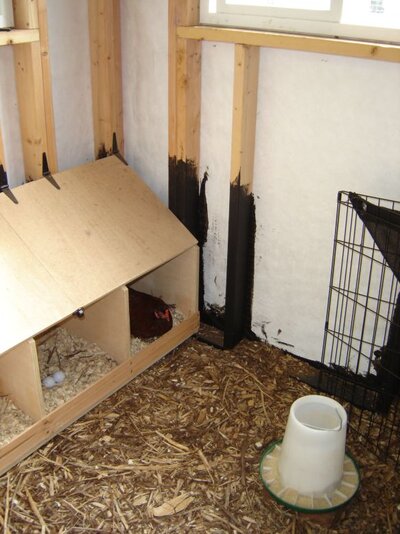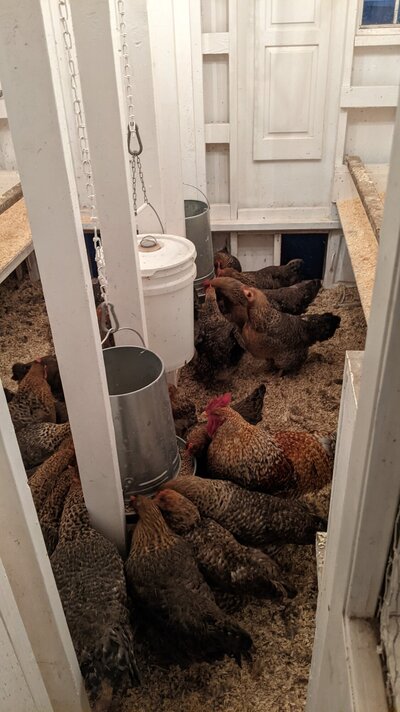Dang. You're doing it all right. Maybe you would just be happier with a lovely little flock of 6 girls and no boy? It seems that the amount of cleaning is putting a damper on your amount of enjoyment from your flock. Let's turn that around.They free range on about 2 acres daily, poop boards are under roosts. I cleaned it all day yesterday and cleaned off about 10 lbs of poop this morning off just the boards. Is sand easier to manage poop than pine?
Navigation
Install the app
How to install the app on iOS
Follow along with the video below to see how to install our site as a web app on your home screen.
Note: This feature may not be available in some browsers.
More options
You are using an out of date browser. It may not display this or other websites correctly.
You should upgrade or use an alternative browser.
You should upgrade or use an alternative browser.
I inherited 22 hens and a rooster. Cleaning help please!!!
- Thread starter MamaBirda
- Start date
Poop boards are fantastic, as long as they work. Mine have a lip on them to keep the sweet PDZ on it, and they work very well. (PDZ, if you don't know, is sold at places like TSC; check the horse section and look for "stall refresher.") The PDZ really helps with the ammonia smell.You could also do poop boards (under their roost bars as they sleep).
Yes, the more, the better, with photos.Second, could we see more photos of the coop in and out? Especially photos of the ventilation?

One way to know if you have enough ventilation is to check the relative humidity in the coop. It should stay very close to the RH outside. If it's more than 5% (ish) higher, consider adding more ventilation.
Roofing the run will help a lot. Can you put up a tarp in the mean time? I did that last year, and it worked very well. I had raked up leaves in the run, and they stayed dry, for the most part.Please allow me to add the run is not covered, I plan to add roofing this spring, but the rain just soaks everything allowing the birds track in mud/poop/etc as well.
And, welcome to BYC.
Going to wait on more coop photos to see if I can make a better suggestion other than changing the layout in there (you have a good amount of actual floor space but it is cluttered in there!)
For the run, two things: see about improving the drainage if drainage is an issue at the location, and also consider switching to deep litter. My run is uncovered and I had a mud/odor issue when I first started, but I started using deep litter and it gradually fixed itself with no extra effort from me.
Start off with a base of chunky wood chips for drainage and aeration. Ideally you'd want aged chips but it's easier to get fresh ones and set aside for aging (though you can start building up thin layers of chips immediately to help with your mud issue). If you have room in the yard to hold onto a load of chips, tree companies (at least in my area) are always looking to offload chips and will do so for free/a small tip.
Now it's a little late in the season for gathering these, but if you have neighbors still putting out bags of dried leaves, those are a great add in on top of the chips. I store bags of dried leaves in my greenhouse each fall for use in the run. Non-toxic weeds and garden trimmings can also be added through the year. In summer, I add in short grass clippings left out a day or two to dry.
My uncovered run floor the morning after a night of heavy rain... it's surface dry even though there's standing puddles in the lawn surrounding the run.

I also use wood chips as my main litter inside the coop, mainly because it's free and readily available, however my birds don't poop a lot inside the coop as I mostly feed and water outside (I keep 1 dry feeder inside the coop). As I do not use poop boards I buy hemp bedding for use under the roost so I can sift poop out for composting.

For the run, two things: see about improving the drainage if drainage is an issue at the location, and also consider switching to deep litter. My run is uncovered and I had a mud/odor issue when I first started, but I started using deep litter and it gradually fixed itself with no extra effort from me.
Start off with a base of chunky wood chips for drainage and aeration. Ideally you'd want aged chips but it's easier to get fresh ones and set aside for aging (though you can start building up thin layers of chips immediately to help with your mud issue). If you have room in the yard to hold onto a load of chips, tree companies (at least in my area) are always looking to offload chips and will do so for free/a small tip.
Now it's a little late in the season for gathering these, but if you have neighbors still putting out bags of dried leaves, those are a great add in on top of the chips. I store bags of dried leaves in my greenhouse each fall for use in the run. Non-toxic weeds and garden trimmings can also be added through the year. In summer, I add in short grass clippings left out a day or two to dry.
My uncovered run floor the morning after a night of heavy rain... it's surface dry even though there's standing puddles in the lawn surrounding the run.

I also use wood chips as my main litter inside the coop, mainly because it's free and readily available, however my birds don't poop a lot inside the coop as I mostly feed and water outside (I keep 1 dry feeder inside the coop). As I do not use poop boards I buy hemp bedding for use under the roost so I can sift poop out for composting.

This is a good note to make
This is a good note to make. I also don't feed or water inside the henhouse, so they don't poop much in there except overnight.Going to wait on more coop photos to see if I can make a better suggestion other than changing the layout in there (you have a good amount of actual floor space but it is cluttered in there!)
For the run, two things: see about improving the drainage if drainage is an issue at the location, and also consider switching to deep litter. My run is uncovered and I had a mud/odor issue when I first started, but I started using deep litter and it gradually fixed itself with no extra effort from me.
Start off with a base of chunky wood chips for drainage and aeration. Ideally you'd want aged chips but it's easier to get fresh ones and set aside for aging (though you can start building up thin layers of chips immediately to help with your mud issue). If you have room in the yard to hold onto a load of chips, tree companies (at least in my area) are always looking to offload chips and will do so for free/a small tip.
Now it's a little late in the season for gathering these, but if you have neighbors still putting out bags of dried leaves, those are a great add in on top of the chips. I store bags of dried leaves in my greenhouse each fall for use in the run. Non-toxic weeds and garden trimmings can also be added through the year. In summer, I add in short grass clippings left out a day or two to dry.
My uncovered run floor the morning after a night of heavy rain... it's surface dry even though there's standing puddles in the lawn surrounding the run.
View attachment 2914574
I also use wood chips as my main litter inside the coop, mainly because it's free and readily available, however my birds don't poop a lot inside the coop as I mostly feed and water outside (I keep 1 dry feeder inside the coop). As I do not use poop boards I buy hemp bedding for use under the roost so I can sift poop out for composting.
View attachment 2914577
I did the deep litter method this summer and even with cleaning every day to three days, the smell was overwhelming.
If you're having to clean like that you can't have been using enough bedding. How much did you put down at a time?
You shouldn't put down a foot all at once, but you build it up in layers of a few inches at a time until you've got as much as the coop will hold or until you want to harvest it for compost.
I think I see soffit ventilation, but if that tiny cupola is the only roof-peak ventilation that could be part of your problem. Ammonia rises and needs to be vented at the peak of the roof. Heat, of course, also rises and because warm air holds more moisture that is critical for keeping the inside of your coop dry.
This illustration is from an article on cattle barns, but the principle is the same for chickens:
As you see it's laminate wood flooring which is already moisture warped. I might remove for regular floorboards? I think...
I did the deep litter method this summer and even with cleaning every day to three days, the smell was overwhelming.
I'd definitely NOT attempt deep litter in the coop with this flooring as the floor is already taking moisture damage (run is different, absolutely try deep litter). Deep litter favors having moisture for composting down poop, therefore it doesn't work in most coop set ups.
You mentioned trying sand for the coop, which can work if you're willing to scoop it out daily. I know there's specific sizes of sand that folks favor but I know very little about it, so unfortunately I can't make recommendations.
A sloped top/cover on top of the nest box will prevent birds from sleeping up there. A simple way to make one is to hinge a piece of scrap plywood over the top of the nests. 45 degree slope as shown below is ideal, I've watched a chicken try to sit on top of my nests and slooowly slide right off.Most birds are in the roosts but about 5 or so stay perched over the nesting boxes and poop all over the entrances to those.

I'm also curious as to how much roost space you have, as 23 birds = 23' in roost, and not sure you have that much, which might be contributing to birds sleeping on top of the nests.
I do have screens on my windows, just keep in mind they need to be cleared of dust every so often so they don't clog up (I use a broom to loosen and leaf blower to blow them out).As far as the venting goes, I'll be adding screens to roof line vents to help with flys. Summer time is horrendous. Already dealt with fly strike. Three of four small windows have screens and two large windows don't open. I don't open the non-screened window as it's not covered by the chicken wire of the run.
Incidentally chicken wire isn't predator proof, but it'd be costly to replace/layer on that much hardware cloth. Might want to look into electric for extra security against bigger predators.
What I do is just add a bit on top to cover over when it looks poopy. Then it looks clean again and nature miraculously breaks everything down so it really becomes clean.Ok. That's a great tip on a little at a time... I probably was putting down too much at once.
I recently had to dig down to base level (which for me is dirt) in order to do some construction in the corner under the roost. The poopiest part of everywhere. And down at the bottom it had all turned into lovely fine soil which is going straight on the roses!
- Thread starter
- #42
MamaBirda
In the Brooder
- Nov 30, 2021
- 14
- 37
- 39
No. Down the center of the coop used to be a septum wall with chicken wire. I presume for separate flocks/chicks. I might remove the beams to the floor to expand space and access for me and the birds. I'll also move the food out to the run.Do you mean the studs that form the chicken wire wall shown here?:

Attachments
I'll give you my person answer and then some other ideas:
My answer: I would start chowin' down on some chicken to lighten the load on the coop (fewer birds = less poop). Although you're doing OK based on square footage, it is a lot to clean.
Better answer: Free range them out into the yard/field/pasture. If they free range all day then they will be happier, healthier, and there will be less to clean. They will have fewer infestation problems from soiled bedding and cleaner feet. You will have a loss rate, but if it is manageable then I would say go for it.
You could also do poop boards (under their roost bars as they sleep).
Edit to say you also have to feed them less when they free range.
My answer: I would start chowin' down on some chicken to lighten the load on the coop (fewer birds = less poop). Although you're doing OK based on square footage, it is a lot to clean.
Better answer: Free range them out into the yard/field/pasture. If they free range all day then they will be happier, healthier, and there will be less to clean. They will have fewer infestation problems from soiled bedding and cleaner feet. You will have a loss rate, but if it is manageable then I would say go for it.
You could also do poop boards (under their roost bars as they sleep).
Edit to say you also have to feed them less when they free range.
- Thread starter
- #3
MamaBirda
In the Brooder
- Nov 30, 2021
- 14
- 37
- 39
They free range on about 2 acres daily, poop boards are under roosts. I cleaned it all day yesterday and cleaned off about 10 lbs of poop this morning off just the boards. Is sand easier to manage poop than pine?I'll give you my person answer and then some other ideas:
My answer: I would start chowin' down on some chicken to lighten the load on the coop (fewer birds = less poop). Although you're doing OK based on square footage, it is a lot to clean.
Better answer: Free range them out into the yard/field/pasture. If they free range all day then they will be happier, healthier, and there will be less to clean. They will have fewer infestation problems from soiled bedding and cleaner feet. You will have a loss rate, but if it is manageable then I would say go for it.
You could also do poop boards (under their roost bars as they sleep).
New posts New threads Active threads
-
Threads with more replies in the last 15 days
-
Checking-In On Peeps - Post Here To Say Hello!
- Started by Nifty-Chicken
- Replies: 1K
-
-
-
-
Can I get some help from someone with careless neighbours who own dogs.
- Started by RiDaGeckoGuy
- Replies: 103
-




